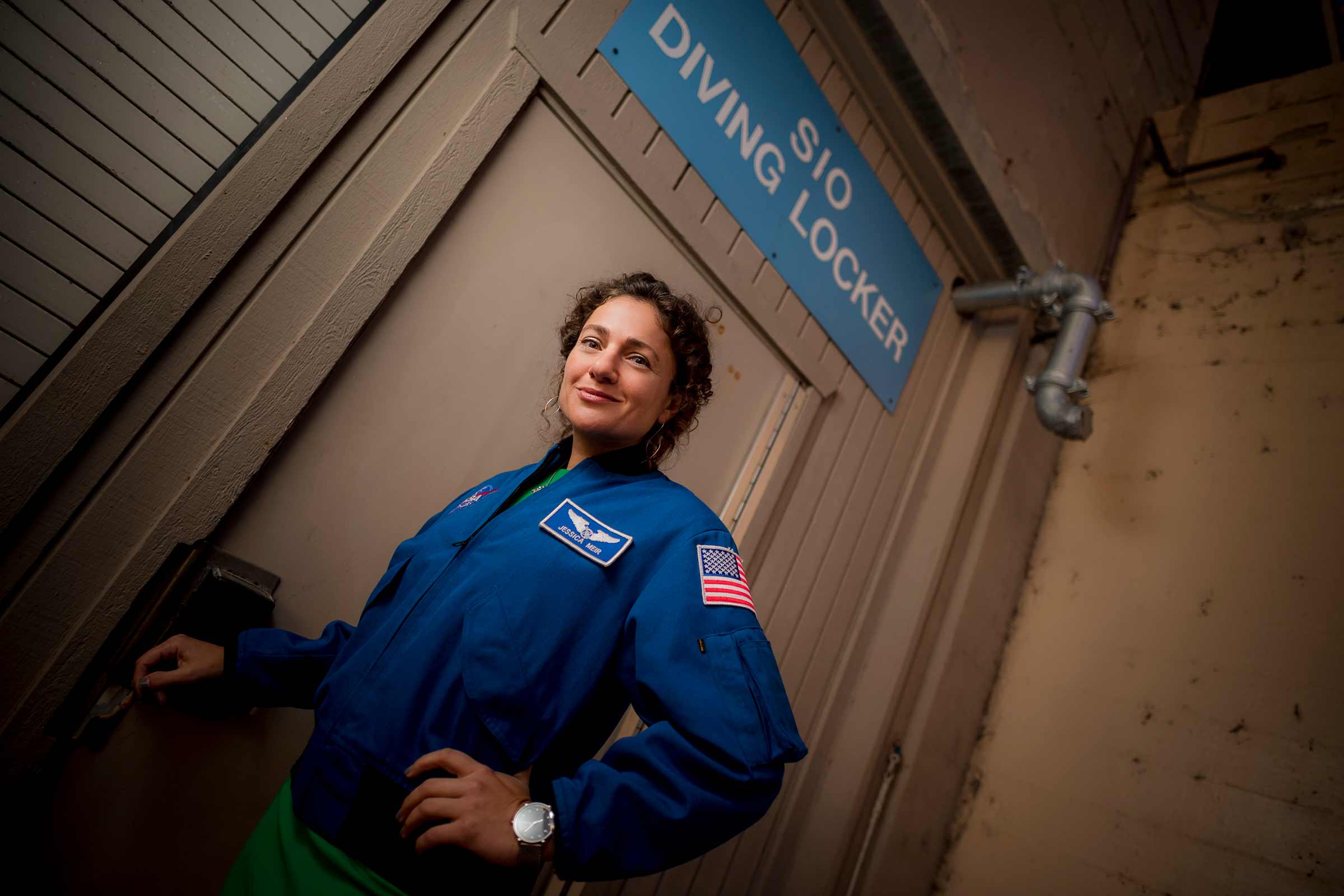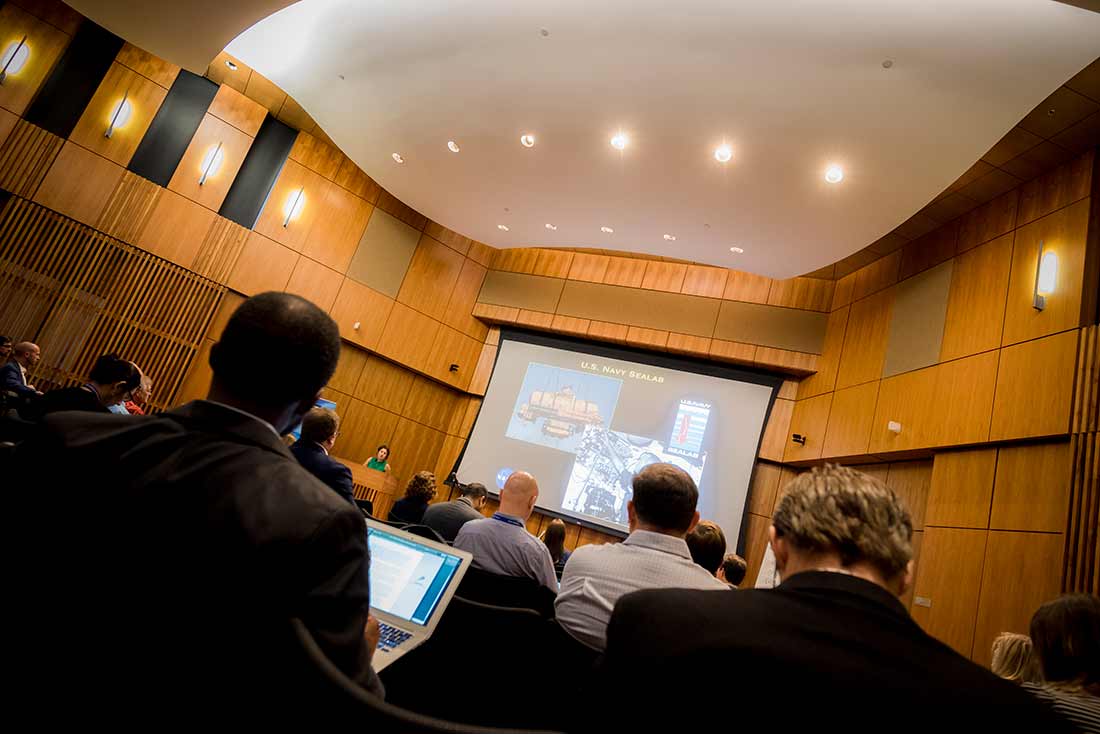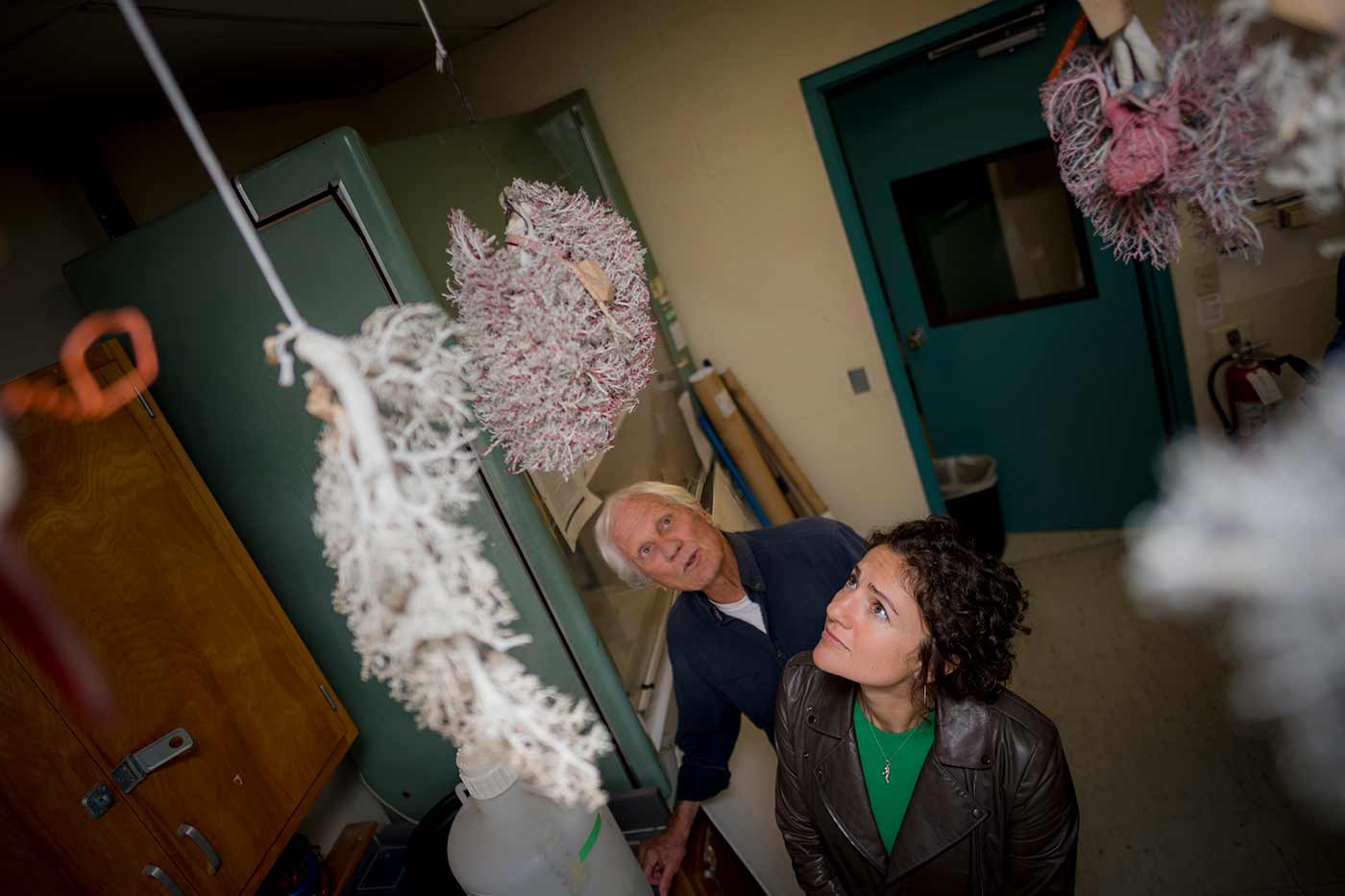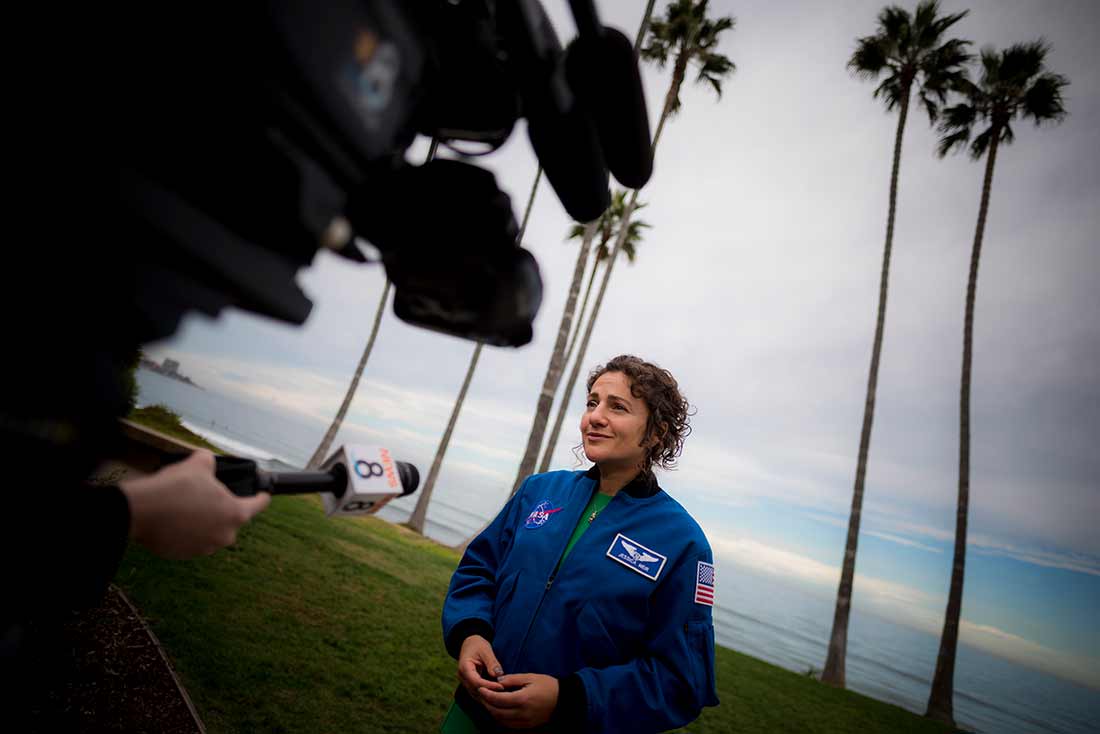
By:
- Brittany Hook
Published Date
By:
- Brittany Hook
Share This:
NASA Astronaut Jessica Meir Orbits Back to Scripps for Campus Visit
Scripps alumna delivered keynote address at Blue Tech Week, engaged in roundtable discussion with students, and participated in Facebook Live Q&A during visit

Jessica Meir visits the Scripps Diving Locker, her old stomping grounds where she was trained to become a scientific diver as a graduate student. Photos by Erik Jepsen/UC San Diego Publications
Jessica Meir is one of a few scientists and UC San Diego alumni who also hold the prestigious title of NASA astronaut. Meir obtained her Ph.D. in marine biology from Scripps Institution of Oceanography in 2009. Last week, she returned to her alma mater to serve as keynote speaker for Blue Tech Week, an event led by the Maritime Alliance. The event that attracted more than 400 participants from academia, finance, government, industry, and the military to focus on the theme of "Smart Ocean, Smart Water."
After discussing the intersections of space and ocean science at the Blue Tech conference, Meir spent the rest of her daylong visit engaging with Scripps students through small, seminar style presentations and lively roundtable discussions. She also interacted with members of the public through a Facebook Live Q&A that encouraged viewers to submit questions.
Buzzing with curiosity, many students asked Meir questions about her unique journey from academia to NASA, advice on navigating a career in science, and more.
As a graduate student, Meir studied the diving physiology of marine mammals and birds, focusing on oxygen depletion in diving emperor penguins in Antarctica and elephant seals in Northern California. This research is relevant both to understanding the dive behavior of these species but also for biomedical applications such as minimizing damage during heart attacks and strokes.

Jessica Meir delivers the keynote address, titled “Space Assets and the Intersection of Water, Ocean, and Space Economies,” at Blue Tech Week inside the Robert Paine Scripps Forum for Science, Society and the Environment on Nov. 7.
Meir explained that her training as a Scripps graduate student, particularly her time spent conducting fieldwork in remote locations such as Antarctica, likely helped her secure the NASA position.
“The skills that are really important to being an astronaut now are learning how to work well in a small team in an isolated environment, not just a harsh environment,” explained Meir. “You're on the Space Station for six months with five other people, so if you have that kind of teamwork experience, particularly if it's in a more stressful environment like working in the Antarctic or in a field camp, it might help you stand out from other applicants.”
She credits Scripps’ Scientific Diving Program with training her to become a world-class diver. This training enabled her to dive beneath the sea ice in Antarctica to conduct research on diving penguins. Meir lit up when she recalled her first experience diving in Antarctica.
“You have hundreds of feet of visibility so it’s actually a little bit disorienting when you first jump in. You feel like you're not in water, because normally in water, you can't see that far, so you almost feel like you're still looking through air,” she explained. “And then the sunlight comes through the cracks or the dive hole and other cracks in the ice and kind of shoots these Highway to Heaven-like rays coming down from above. It's really extraordinary.”
Among her many skills and accomplishments, Meir’s unique diving and research experience helped her stand out from 6,000 qualified applicants to secure one of eight spots in the NASA astronaut class of 2013. It had been a childhood dream of Meir’s to become an astronaut and to finally see it come true was “unforgettable,” particularly because she had applied twice before and failed to make the final cut.
Since joining NASA, Meir has gone through the Astronaut Candidate Training where she completed intensive instruction in International Space Station systems, spacewalks, robotics, physiological training, flight training, and water and wilderness survival training. She completed training in July 2015, and is now qualified for future assignment—which will likely include a visit to the International Space Station within the next 5-10 years.
UC San Diego is an innovative hub for NASA hopefuls; Meir is just one of four alumni that are astronauts. Megan McArthur, who also studied at Scripps, traveled to space in 2009 and helped repair the Hubble telescope; Kate Rubins spent 115 days at the International Space Station in 2016; and Robb Kulin joined NASA’s newest class of astronauts June 2017.

Scripps research physiologist Jerry Kooyman and alumna Jessica Meir visit the lab of Scripps researcher Paul Ponganis in Scholander Hall, complete with hanging casts of the airways and blood vessels found in marine mammal lungs. Kooyman and Ponganis were Meir’s advisors and mentors while she was pursuing a Ph.D. at Scripps.
Meir is hopeful that NASA astronauts will journey to Mars in her lifetime. “Everything we're doing on the Space Station, and everything we're doing with our robotic spacecraft that have been to Mars already are helping us get there,” she said. “I'm not sure whether or not we'll get all the way to Mars in my career, but I hope that I can help us get there.”
One student asked a question about what NASA looks for in astronaut candidates.
“The most important skill to being an astronaut is to be operational and adaptable,” said Meir. “You have to be able to do operational skills such as scuba diving and flying airplanes and other activities that require a lot of situational awareness, and you have to be coordinated and able to function in these types of extreme environments.”
Another student asked Meir if she had encountered any challenges along the way, and how she dealt with them. To the surprise of many in the room, Meir, who exudes confidence and poise, said that during graduate school she suffered from “imposter syndrome,” the feeling that she didn’t really belong there and that she was a fraud compared to her peers.
She ultimately got over these fears, having a sort of “aha” moment as she was defending her dissertation. She recalls looking out into the audience and realizing all the hard work she had put into her studies. “I don’t know what it was about that moment, but I finally had the perspective that I had done a ton of work, and I do deserve this,” she said.
She encouraged others feeling similar thoughts to “just keep going,” noting that perspective is gained with time. “I say ‘Fake it ‘til you make it’ as a joke, but it’s kind of true,” she said.
Another student asked Meir if she had any mentors or advisors who provided support throughout her career. Meir credited Scripps advisors Paul Ponganis and Gerald “Jerry” Kooyman with being instrumental in guiding her along her journey at Scripps and beyond.

Astronaut Jessica Meir is interviewed by local media during her Nov. 7 visit to Scripps Oceanography.
“I had these mentors that were not only at the top of the game in terms of their scientific field, but they're also just really good people,” said Meir. “Paul and Jerry really cared about me as a person—not only as a scientist—and they're both incredibly successful but also modest. I encourage all of you to seek out really good mentors because they can be really important in helping you shape what you're going to do and provide that necessary support.”
When asked for advice on how to have a successful and fulfilling career in science, Meir provided three tips: Identify your passion, define your path, and accept that you’ll fail along the way.
Recent Scripps graduate Kate Furby said she loved sitting in on Meir’s talks and appreciated the candid conversation.
“I could listen to Jessica talk about being an astronaut all day. She is an inspiring explorer of remote places, first the Antarctic and now the universe,” said Furby, who now runs a science communication business. “We need people like Jessica now more than ever: inspiring women and strong scientists.”
As a NASA astronaut, Meir often visits classrooms and engages in speaking and outreach activities to inspire the next generation—something she considers to be very important. She encouraged students in the room to also give back and be good mentors to others.
"Even if you feel like you're just starting or halfway through grad school, you’re already further along than somebody else that's seeking advice, so remember to be a good mentor as well,” she said. “You've got to pay it forward.”
Share This:
You May Also Like
Stay in the Know
Keep up with all the latest from UC San Diego. Subscribe to the newsletter today.


